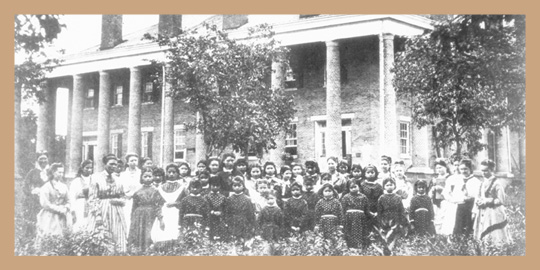Seminary Records

Seminary Records
MASSACHUSETTS MISSIONARIES
Reverend Samuel Worcester and Reverend Doctor Elizur Butler began their missionary work among the Cherokee Tribe in Georgia before their removal, by the United States Government, to Indian Territory in Oklahoma. Each missionary’s daughter, Sarah and Esther respectively, grew up white among the Cherokee people and then returned to Massachusetts to study at Mount Holyoke Seminary. William P. Ross ( nephew of Chief John Ross and later Chief) and David Vann, influential Cherokee men during that time, served as cultural brokers to the Reverends; together they began to implement educational plans at the Park Hill Mission Station. There were to be two seminaries, one at Park Hill for women and another some miles away for men.
CHEROKEE CONSTRUCTION
The first cornerstone was laid for the Cherokee Female Seminary on June 21st, 1847 at the Park Hill Mission Station(2) As construction occurred, Ross and Vann traveled to New England in 1850 to tour the Mount Holyoke Seminary, at the same time that the Worcester and Butler girls were enrolled. After their visit, they decided to use Mount Holyoke Seminary as a model for their own female seminary, borrowing programs of study and even Mount Holyoke graduates as principals and teachers. The Cherokee Female Seminary was opened to students a year later by Mount Holyoke Seminary graduates, Miss Ellen Whitmore and Miss Sarah Worcester on May 7th, 1851. Wilma Mankiller, first female chief of the Cherokee Nation commented on the male and female seminaries in Oklahoma, saying that “the Cherokee Seminaries were among the first educational systems built west of the Mississippi-Indian or non-Indian. In fact, for a period of time during the mid-nineteenth century, the Cherokee population was more literate than the neighboring non-Indian population” (3) This attests to the success of the Cherokee Female Seminary in bringing education to a population possessing few of their own institutions for higher learning.
APPEARANCE AND ASSIMILATION
The first structure housing the Cherokee Female Seminary, although built prior to the Cherokee’s trip to South Hadley, was physically similar to that of Mount Holyoke Seminary. Ross and Vann had hired a contractor out of Boston, Massachusetts to design and build the Cherokee Female Seminary so that it resembled structures in the eastern United States.(4) Reflections of both, industrial and asylum structures could be seen in the architecture for institutions of higher learning, but t he similarities between the Cherokee Female Seminary and Mount Holyoke Seminary went far beyond appearances.
Article courtesy of Mount Holyoke College
